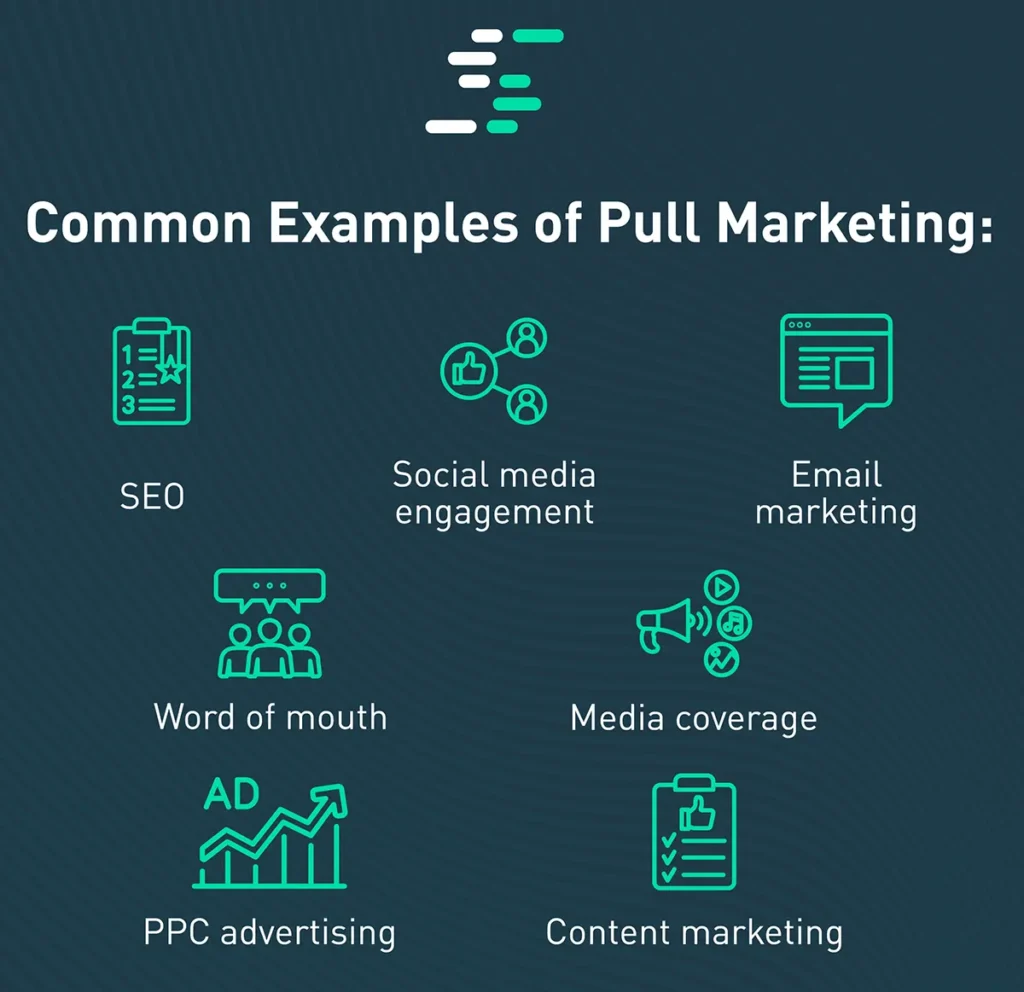The terms “push” and “pull marketing” have been around for a long time. Marketers have based strategies around both concepts for decades. Examples of companies that benefited from strategies like these include giants like Wal-Mart.
If push and pull marketing strategies have been around so long, what are they and how are they different? To answer this question, let’s start with defining what exactly a push marketing vs. a pull marketing strategy looks like.
Pull Marketing
As the name implies, pull marketing is about drawing customers to a brand, company, or product. Some of the most popular forms of modern marketing, such as SEO or search engine optimization, are pull marketing strategies. You could say that pull marketing is the basis of all digital marketing in this way.
The point of pull marketing is to build up brand awareness and demand for the products related to that brand. You want to draw customers to a business or brand so that they see what they need. Pull marketing can be subtle or straightforward and has as high of an ROI as any other form of marketing.
One of the clearest examples of pull marketing is advertising children’s toys on a children’s TV program. This way, you build up demand for the toy amongst the consumers of that toy: children. They will ask for it, want it, and relay their desire to have the toy you make to their parents.
Of course, all industries are different, but you can see how this applies across the board. This is especially true when dealing with digital markets such as social media, where it is easy to target specific demographics and groups of people.
Examples of Pull Marketing
Here are several common examples of pull marketing:
- SEO
- Social media engagement
- Email marketing
- Word of mouth
- Media coverage
- Content marketing
- PPC advertising


Why Engage in Pull Marketing?
Pull marketing has proven itself to be undeniably effective at growing businesses. Many small scale businesses have become success stories because of it. One of the growing reasons for this is the explosion of social media and search engine driven marketing approaches.
Pull marketing strategies take full advantage of modern resources. If a company has a limited marketing budget, using pull marketing strategies can give them the best bang for their ad dollars. This becomes even truer once consumers desire or seek after those products.
Pull marketing also takes full advantage of reconnecting with customers that have already purchased products from a company or brand. These resources can make a huge difference and generate quality leads based on consumers that already have experience with a brand or company, often lowering the cost of acquisition for decent quality leads.
Push Marketing
Push marketing is a general advertisement where a company attempts to bring what they offer to the customer. This is the opposite of pull marketing, where the attempt is to draw a customer to the corporation or brand. The epitome of push marketing is trying to sell products directly to customers.
The term “push” is used here to explain how the product is shown to consumers. In a push marketing campaign, a company or brand will push their product out front to be seen. Appeals can be made directly to the consumer then, to purchase the product in question.
Push marketing strategies can best be seen in brick-and-mortar businesses. Selling an item on a sales floor is a form of push marketing. This strategy has worked well for certain companies but often favors large, established brands over small businesses that are just beginning.
For push marketing to succeed, the right products have to be displayed and presented, and the right consumer group has to be appealed to. This can come in the form of demographic marketing, understanding a local area and the shoppers there, etc. Traditional marketing is often seen as push marketing.
Examples of Push Marketing
Here are some common examples of what push marketing looks like:
- Showroom floor sales
- Trade shows
- Displays at point of sale
- TV ads
- Radio ads
- Appealing packaging options
Why Use Push Marketing?
The main reason why businesses use push marketing is to drive sales in a quick, efficient manner. If they already have a large consumer base, push marketing can be an easy and effective way to generate interest or sales with new products.
This works well for companies that already have established brands, such as Nike, Coca-Cola, or other major corporations. Their brand image is so powerful that they don’t have to use all of their marketing efforts on branding or awareness but more on pushing products to their consumers.
There is also a nostalgia to push marketing, as the marketing campaigns most of us remember from our childhood were almost always push marketing campaigns. From the famous television ads of the 80s and 90s to the amazing Superbowl commercials of the turn of the millennium, all of these were pure push marketing strategies.
Which Should My Company Choose?
If a business has limited dollars to spend on its marketing campaign, and isn’t in an industry solely driven by a salesforce or tradeshow growth, the overwhelming choice should be pull marketing. You get a much higher return on your investment and organic growth through traffic and content appeal.
One of the key themes discovered through online advertising and marketing is that the smaller company can win. The way they win is by utilizing pull marketing strategies to defeat their larger competition. In many ways, the digital marketplace has equalized the chance of success, whereas traditional marketing has always favored larger corporations.

Push Marketing vs. Pull Marketing
If your business takes place in the digital and/or people look for you in the digital then for a long term, results-driven ROI, pull marketing has become the favored choice. This has impacted both large and small businesses. In so many new and old industries, digital marketing and social media marketing have become the most crucial channels to grow a business.
Modern push marketing is often used sparingly to jumpstart sales for specific products. Large businesses, particularly retailers like Wal-Mart and Costco, are also able to leverage push marketing. For the rest of the companies out there, don’t try to compete with the giants at what they excel at. Go a different route. Some industries, are still fairly untouched by digital marketing, these industries are still driven by relationships/networking, which is networking marketing – and we would have to lump this into push marketing.
When digital is the battleground, focusing on online marketing and advertising, building brand awareness, and engaging content is how David defeats Goliath.
